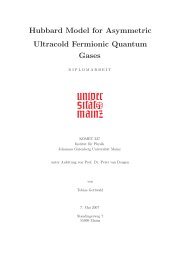5 Hirsch-Fye quantum Monte Carlo method for ... - komet 337
5 Hirsch-Fye quantum Monte Carlo method for ... - komet 337
5 Hirsch-Fye quantum Monte Carlo method for ... - komet 337
You also want an ePaper? Increase the reach of your titles
YUMPU automatically turns print PDFs into web optimized ePapers that Google loves.
<strong>Hirsch</strong>-<strong>Fye</strong> QMC 5.27<br />
1<br />
(a) (b)<br />
E (4)<br />
kin<br />
E (2)<br />
kin<br />
0.5<br />
0<br />
-0.5<br />
0<br />
-0.2<br />
-0.4<br />
-0.6<br />
E (2)<br />
kin /Ekin 1.5<br />
1<br />
0.5<br />
0<br />
0 2 4<br />
U<br />
6 8<br />
0 1 2 3 4 5 6 7 8<br />
U<br />
T=1/15<br />
T=1/25<br />
T=1/50<br />
D (4)<br />
D (2)<br />
0.2<br />
0<br />
-0.2<br />
0.15<br />
0.1<br />
0.05<br />
0<br />
-0.05<br />
0.05<br />
0.00<br />
-0.05<br />
0 5 10 15 20<br />
0 1 2 3 4 5 6 7 8<br />
U<br />
T=1/15<br />
T=1/25<br />
T=1/40<br />
T=1/50<br />
Fig. 17: (a) Coefficients of Trotter errors in HF-QMC estimates of kinetic energy. Inset: relative<br />
coefficients. (b) Trotter coefficients <strong>for</strong> double occupancy [47].<br />
theory (RDMFT) [49, 50] as well as their applications, e.g., in the context of cold atoms on<br />
optical lattices. It would also be tempting and potentially fruitful to explore the similarities<br />
between the HF-QMC approach and the determinantal QMC <strong>method</strong> [33] <strong>for</strong> Hubbard model<br />
studies in finite dimensions, in particular its recent application as DMFT impurity solver [51].<br />
However, one has to stop at some point and the material presented so far is probably already<br />
overwhelming <strong>for</strong> students and scientists just entering the field.<br />
This audience should be aware of the fact that the future relevance of the HF-QMC <strong>method</strong> is<br />
controversial; influential groups claim that it has been superseded by the continuous-time QMC<br />
<strong>method</strong>s. These <strong>method</strong>s are, indeed, conceptually elegant and avoid the systematic discretization<br />
bias which can be cumbersome in conventional HF-QMC calculations. We have shown,<br />
however, that the HF-QMC <strong>method</strong> is competitive at least <strong>for</strong> some classes of problems already<br />
in the conventional <strong>for</strong>m [47]; the quasi-continuous time <strong>for</strong>mulation in the multigrid approach<br />
eliminates most of the remaining problems. Consequently it seems too early to abandon the<br />
general HF-QMC concept.<br />
Acknowledgments<br />
The authors thanks E. Gorelik and D. Rost <strong>for</strong> valuable help in preparing these lecture notes.<br />
Support of the Deutsche Forschungsgemeinschaft through FOR1346 is gratefully acknowledged.<br />
Appendices<br />
A Multi-band Hubbard models<br />
The applicability of the one-band Hubbard model todorf electron systems is a priori questionable<br />
since the partially filled bands correspond to atomic orbitals which are 5-fold and 7-fold<br />
degenerate (<strong>for</strong> each spin direction), respectively. While bands in a lattice are more complicated<br />
than orbitals of isolated atoms, the remaining degeneracy can be inferred from symmetry













